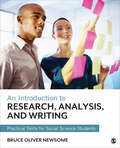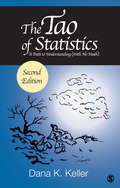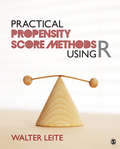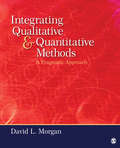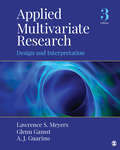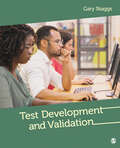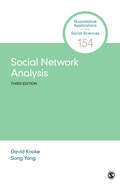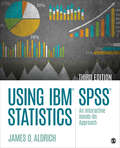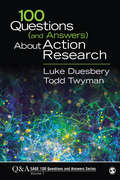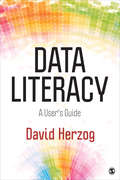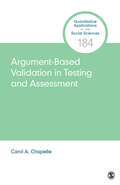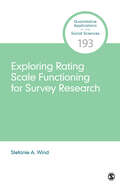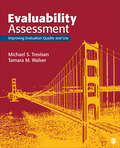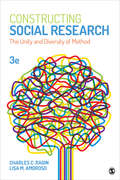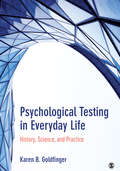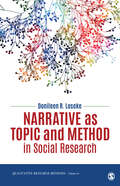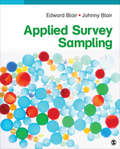- Table View
- List View
An Introduction to Research, Analysis, and Writing: Practical Skills for Social Science Students
by Bruce Oliver NewsomeThis accessible guide walks readers through the process of completing a social science research project. Written specifically to meet the needs of undergraduate research classes, it introduces students to a complete skill set, including: planning, design, analysis, argumentation, criticizing theories, building theories, modeling theories, choosing methods, gathering data, presenting evidence, and writing the final product. Students can use this text as a practical resource to navigate through each stage of the process, including choices between more advanced research techniques.
The Tao of Statistics: A Path to Understanding (With No Math)
by Dana K. KellerThis Second Edition of The Tao of Statistics: A Path to Understanding (With No Math) provides a reader-friendly approach to statistics in plain English. Unlike other statistics books, this text explains what statistics mean and how they are used, rather than how to calculate them. The book walks readers through basic concepts as well as some of the most complex statistical models in use. The Second Edition adds coverage of big data to better address its impact on p-values and other key concepts; material on small data to show readers how to handle data with fewer data points than optimal; and other new topics like missing data and effect sizes. The book’s two characters (a high school principal and a director of public health) return in the revised edition, with their examples expanded and updated with reference to contemporary concerns in the fields of education and health.
Practical Propensity Score Methods Using R
by Walter L. LeiteThis practical book uses a step-by-step analysis of realistic examples to help students understand the theory and code for implementing propensity score analysis with the R statistical language. With a comparison of both well-established and cutting-edge propensity score methods, the text highlights where solid guidelines exist to support best practices and where there is scarcity of research. Readers will find that this scaffolded approach to R and the book’s free online resources help them apply the text’s concepts to the analysis of their own data.
Integrating Qualitative and Quantitative Methods: A Pragmatic Approach
by David L. MorganFocusing on research designs for projects that collect both qualitative and quantitative data, this practical book discusses strategies for bringing qualitative and quantitative methods together so that their combined strengths accomplish more than is possible with a single method. The approach is broadly interdisciplinary, reflecting the interest in mixed methods research of social scientists from anthropology, communication, criminal justice, education, evaluation, nursing, organizational behavior, psychology, political science, public administration, public health, sociology, social work, and urban studies. In contrast to an "anything goes" approach or a naïve hope that "two methods are better than one," the author argues that projects using mixed methods must pay even more attention to research design than single method approaches. The book’s practical emphasis on mixed methods makes it useful both to active researchers and to students who intend to pursue such a career.
Applied Multivariate Research: Design and Interpretation
by Lawrence S. Meyers Glenn C. Gamst Anthony J. GuarinoUsing a conceptual, non-mathematical approach, the updated Third Edition provides full coverage of the wide range of multivariate topics that graduate students across the social and behavioral sciences encounter. Authors Lawrence S. Meyers, Glenn Gamst, and A. J. Guarino integrate innovative multicultural topics in examples throughout the book, which include both conceptual and practical coverage of: statistical techniques of data screening; multiple regression; multilevel modeling; exploratory factor analysis; discriminant analysis; structural equation modeling; structural equation modeling invariance; survival analysis; multidimensional scaling; and cluster analysis.
Test Development and Validation
by Gary Edward SkaggsTest Development and Validation by Gary Skaggs summarizes the latest test theories, frameworks for test development and validation, and guidance for developing tests in straightforward language in one core text. Students looking for clear, concise explanations of measurement, validity, and test development within a real-world context and with numerous examples will find this book to be an excellent learning resource. Author Gary Skaggs takes years of experience teaching test development to graduate students across social and behavioral sciences and consulting on a wide variety of government and institutional research projects to offer students a thorough, jargon-free, and highly applied book to help propel their own research and careers. Part I of the book, The Big Picture, sets the stage for test development, placing it within the larger context and history of measurement, emphasizing measurement concepts and their evolution over time. Part II, Test Development, covers the technical details of instrument and test development in logical order. Validation, Part III, links the conceptual bases provided in Part I with the technical process provided in Part II to conclude the book. For those students wanting to go further, software suggestions are referenced in the technical chapters, while Further Reading sections offer the original sources for more details. Exercises and Activities at the end of each chapter provide students a variety of ways to apply their knowledge, from conceptual questions to brief project ideas to data analysis problems.
Introduction to Cognitive Ethnography and Systematic Field Work (Qualitative Research Methods)
by G. Mark SchoepfleIntroduction to Cognitive Ethnography and Systematic Field Work by G. Mark Schoepfle provides a guide to the fundamentals of cognitive ethnography for qualitative research. A focus of this technique is collecting data from flexible but rigorous interviews. These interviews are flexible because they are designed to be structured around the semantic knowledge being elicited from the speaker, not around some pre-conceived design that is based on the researcher’s background, and they are rigorous because the basic linguistic and semantic structures are shared among all cultures. Written by one of the founders of this technique, this text provides a wealth of concentrated knowledge developed over years to best suit this collaborative and participant-centric research process. Eight chapters show how intertwined data collection and analysis are in this method. The first chapter offers a brief history and overview of the cognitive ethnography. Chapter 2 covers planning a research project, from developing a research question to ethics and IRB requirements. The next two chapters cover interview background, techniques, and structures. Chapter 5 addresses analysis while Chapter 6 covers transcription and translation. Chapter 7 covers observation, while a final chapter address writing a report for both consultants and outside audiences.
Social Network Analysis: Methods And Examples (Quantitative Applications in the Social Sciences #154)
by David Knoke Song YangDavid Knoke and Song Yang′s Social Network Analysis, Third Edition provides a concise introduction to the concepts and tools of social network analysis. The authors convey key material while at the same time minimizing technical complexities. The examples are simple: sets of 5 or 6 entities such as individuals, positions in a hierarchy, political offices, and nation-states, and the relations between them include friendship, communication, supervision, donations, and trade. The new edition reflects developments and changes in practice over the past decade. The authors also describe important recent developments in network analysis, especially in the fifth chapter. Exponential random graph models (ERGMs) are a prime example: when the second edition was published, P* models were the recommended approach for this, but they have been replaced by ERGMs. Finally, throughout the volume, the authors comment on the challenges and opportunities offered by internet and social media data.
Using IBM SPSS Statistics: An Interactive Hands-On Approach
by James O. AldrichNow with a new companion website! Using IBM® SPSS® Statistics: An Interactive Hands-On Approach, Third Edition gives readers an accessible and comprehensive guide to walking through SPSS®, providing them with step-by-step knowledge for effectively analyzing their data. From entering data to working with existing databases, and working with the help menu through performing factor analysis, Using IBM® SPSS® Statistics covers every aspect of SPSS® from introductory through intermediate statistics. The book is divided into parts that focus on mastering SPSS® basics, dealing with univariate statistics and graphing, inferential statistics, relational statistics, and more. Written using IBM® SPSS® version 25 and 24, and compatible with the earlier releases, this book is one of the most comprehensive SPSS® guides available. Bundle Using IBM® SPSS® Statistics: An Interactive Hands-On Approach with SAGE IBM® SPSS® Statistics v24.0 Student Version and SAVE! – Bundle ISBN: 978-1-5443-5071-4
100 Questions (SAGE 100 Questions and Answers #7)
by Luke S. Duesbery Todd M. Twyman100 Questions (and Answers) About Action Research identifies and answers the essential questions on the process of systematically approaching your practice from an inquiry-oriented perspective, with a focus on improving that practice. This unique text offers progressive instructors an alternative to the research status quo and serves as a reference for readers to improve their practice as advocates for those they serve. The Question and Answer format makes this an ideal supplementary text for traditional research methods courses, and also a helpful guide for practitioners in education, social work, criminal justice, health, business, and other applied disciplines.
Data Literacy: A User′s Guide
by David L. HerzogA practical, skill-based introduction to data analysis and literacy We are swimming in a world of data, and this handy guide will keep you afloat while you learn to make sense of it all. In Data Literacy: A User′s Guide, David Herzog, a journalist with a decade of experience using data analysis to transform information into captivating storytelling, introduces students and professionals to the fundamentals of data literacy, a key skill in today’s world. Assuming the reader has no advanced knowledge of data analysis or statistics, this book shows how to create insight from publicly-available data through exercises using simple Excel functions. Extensively illustrated, step-by-step instructions within a concise, yet comprehensive, reference will help readers identify, obtain, evaluate, clean, analyze and visualize data. A concluding chapter introduces more sophisticated data analysis methods and tools including database managers such as Microsoft Access and MySQL and standalone statistical programs such as SPSS, SAS and R.
Argument-Based Validation in Testing and Assessment (Quantitative Applications in the Social Sciences #184)
by Carol A. ChapelleCarol A. Chapelle shows readers how to design validation research for tests of human capacities and performance. Any test that is used to make decisions about people or programs should have undergone extensive research to demonstrate that the scores are actually appropriate for their intended purpose. Argument-Based Validation in Testing and Assessment is intended to help close the gap between theory and practice, by introducing, explaining, and demonstrating how test developers can formulate the overall design for their validation research from an argument-based perspective.
Exploring Rating Scale Functioning for Survey Research (Quantitative Applications in the Social Sciences)
by Stefanie A. WindItems with ordered response categories are common in survey research, such as when respondents are asked how much they agree with certain statements. But how large are the differences between categories of response, and how well do they distinguish between respondents? This volume is the first to introduce the evaluation of rating scales to an audience of survey researchers. Evaluating Rating Scale Functioning for Survey Research provides researchers with an overview of rating scale analysis along with practical guidance on how to conduct such analyses with their own survey data. Author Stefanie A. Wind presents three categories of methods: Rasch models; non-Rasch Item Response Theory (IRT) models; and non-parametric models, together with practical examples. Tutorials, datasets, and software code (R and Facets) to accompany the book are available on the book’s website.
Social Network Analysis: Methods And Examples (Quantitative Applications in the Social Sciences #154)
by David Knoke Song YangDavid Knoke and Song Yang′s Social Network Analysis, Third Edition provides a concise introduction to the concepts and tools of social network analysis. The authors convey key material while at the same time minimizing technical complexities. The examples are simple: sets of 5 or 6 entities such as individuals, positions in a hierarchy, political offices, and nation-states, and the relations between them include friendship, communication, supervision, donations, and trade. The new edition reflects developments and changes in practice over the past decade. The authors also describe important recent developments in network analysis, especially in the fifth chapter. Exponential random graph models (ERGMs) are a prime example: when the second edition was published, P* models were the recommended approach for this, but they have been replaced by ERGMs. Finally, throughout the volume, the authors comment on the challenges and opportunities offered by internet and social media data.
Evaluability Assessment: Improving Evaluation Quality and Use
by Michael S. Trevisan Tamara M. WalserEvaluability assessment (EA) can lead to development of sound program theory, increased stakeholder involvement and empowerment, better understanding of program culture and context, enhanced collaboration and communication, process and findings use, and organizational learning and evaluation capacity building. This book provides an up-to-date treatment of EA, clarifies what it actually is and how it can be used, demonstrates EA as an approach to evaluative inquiry with multidisciplinary and global appeal, and identifies and describes the purposes and benefits to using EA. Using case examples contributed by EA practitioners, the text illustrates important features of EA use, and showcases how EA is used in a variety of disciplines and evaluation contexts. This text is appropriate as an instructional text for graduate level evaluation courses and training, and as a resource for evaluation practitioners, policymakers, funding agencies, and professional training.
Constructing Social Research: The Unity and Diversity of Method (Sociology For A New Century Ser.)
by Charles C. Ragin Lisa M. AmorosoThe updated Third Edition of this innovative text shows the unity within the diversity of activities called social research to help students understand how all social researchers construct representations of social life using theories, systematic data collection, and careful examination of that data. The book tackles questions like "What is social research?", "How does it differ from journalism, documentary film-making, or laboratory research in the natural sciences?", and "What is the researcher′s obligation to those he or she is studying?" Updated throughout with new references and examples, this edition is designed to evoke challenging questions regarding the nature of representation and the ethical challenges facing social scientific researchers. The text moves beyond standard research challenges to push readers to see the complex relationships among ethics, ideas, evidence, and outcomes.
Psychological Testing in Everyday Life: History, Science, and Practice
by Karen B. GoldfingerPsychological Testing in Everyday Life explores how psychological testing is used in real-life settings to make the study of psychometrics interesting, relevant, and highly accessible. Author Karen B. Goldfinger examines a broad range of carefully selected topics to capture student interest, encourage critical thinking, and spark class discussions. Organized in the form of an applied casebook, each chapter presents the complex issues that arise when using psychological tests in a variety of settings, providing an in-depth view of psychological testing practices, historically and in the present. This unique text will support students in becoming thoughtful, informed consumers and providers of psychological assessment.
The Practice of Survey Research: Theory and Applications
by Brian Joseph Gillespie William E. Wagner-Huang Erin RuelUnique in its integration of theory and application, this comprehensive book explains survey design, implementation, data analysis, and continuing data management, including how to effectively incorporate the latest technology (e.g., SurveyMonkey and Qualtrics). Data management and analysis are demonstrated and explained through statistical software including SPSS, SAS, and STATA. In addition to helping students develop a complete understanding of survey research from start to finish, the authors also address the challenges and issues of specific disciplines.
Integrating Qualitative and Quantitative Methods: A Pragmatic Approach
by David L. MorganFocusing on research designs for projects that collect both qualitative and quantitative data, this practical book discusses strategies for bringing qualitative and quantitative methods together so that their combined strengths accomplish more than is possible with a single method. The approach is broadly interdisciplinary, reflecting the interest in mixed methods research of social scientists from anthropology, communication, criminal justice, education, evaluation, nursing, organizational behavior, psychology, political science, public administration, public health, sociology, social work, and urban studies. In contrast to an "anything goes" approach or a naïve hope that "two methods are better than one," the author argues that projects using mixed methods must pay even more attention to research design than single method approaches. The book’s practical emphasis on mixed methods makes it useful both to active researchers and to students who intend to pursue such a career.
Narrative as Topic and Method in Social Research (Qualitative Research Methods)
by Donileen R. LosekeNarrative research is an increasingly popular qualitative method across the social sciences. This book has two purposes: firstly to show students and researchers how to do research on narrative topics, particularly on questions about narrative productions of meaning, and secondly to explain some fundamentals of research methods suitable for exploring these topics. A final part of the book provides empirical examples of how such research is done. These chapters use small amounts of data to examine the analytic tasks of designing research questions, finding appropriate data, sampling decisions, contextualization, data categorization, and communicating study findings.
Using IBM SPSS Statistics: An Interactive Hands-On Approach
by James O. AldrichNow with a new companion website! Using IBM® SPSS® Statistics: An Interactive Hands-On Approach, Third Edition gives readers an accessible and comprehensive guide to walking through SPSS®, providing them with step-by-step knowledge for effectively analyzing their data. From entering data to working with existing databases, and working with the help menu through performing factor analysis, Using IBM® SPSS® Statistics covers every aspect of SPSS® from introductory through intermediate statistics. The book is divided into parts that focus on mastering SPSS® basics, dealing with univariate statistics and graphing, inferential statistics, relational statistics, and more. Written using IBM® SPSS® version 25 and 24, and compatible with the earlier releases, this book is one of the most comprehensive SPSS® guides available. Bundle Using IBM® SPSS® Statistics: An Interactive Hands-On Approach with SAGE IBM® SPSS® Statistics v24.0 Student Version and SAVE! – Bundle ISBN: 978-1-5443-5071-4
An Introduction to Fully Integrated Mixed Methods Research
by Elizabeth G. CreamerThis practical book provides the tools needed to design, execute, and evaluate fully integrated mixed methods research studies. A uniting metaphor of the architectural arch helps students understand the benefits of a mixed methods approach as they consider ways to integrate the qualitative and quantitative strands at all stages of design and execution. With use of examples from popular media and published research, this text also includes a detailed discussion of ways to accomplish mixing methods during data collection and analysis and a separate chapter on designing and executing a realistic mixed methods dissertation.
Evaluability Assessment: Improving Evaluation Quality and Use
by Michael S. Trevisan Tamara M. WalserEvaluability assessment (EA) can lead to development of sound program theory, increased stakeholder involvement and empowerment, better understanding of program culture and context, enhanced collaboration and communication, process and findings use, and organizational learning and evaluation capacity building. This book provides an up-to-date treatment of EA, clarifies what it actually is and how it can be used, demonstrates EA as an approach to evaluative inquiry with multidisciplinary and global appeal, and identifies and describes the purposes and benefits to using EA. Using case examples contributed by EA practitioners, the text illustrates important features of EA use, and showcases how EA is used in a variety of disciplines and evaluation contexts. This text is appropriate as an instructional text for graduate level evaluation courses and training, and as a resource for evaluation practitioners, policymakers, funding agencies, and professional training.
Narrative as Topic and Method in Social Research (Qualitative Research Methods)
by Donileen R. LosekeNarrative research is an increasingly popular qualitative method across the social sciences. This book has two purposes: firstly to show students and researchers how to do research on narrative topics, particularly on questions about narrative productions of meaning, and secondly to explain some fundamentals of research methods suitable for exploring these topics. A final part of the book provides empirical examples of how such research is done. These chapters use small amounts of data to examine the analytic tasks of designing research questions, finding appropriate data, sampling decisions, contextualization, data categorization, and communicating study findings.
Applied Survey Sampling
by Johnny Blair Edward BlairWritten for students and researchers who wish to understand the conceptual and practical aspects of sampling, this book is designed to be accessible without requiring advanced statistical training. It covers a wide range of topics, from the basics of sampling to special topics such as sampling rare populations, sampling organizational populations, and sampling visitors to a place. Using cases and examples to illustrate sampling principles and procedures, the book thoroughly covers the fundamentals of modern survey sampling, and addresses recent changes in the survey environment such as declining response rates, the rise of Internet surveys, the need to accommodate cell phones in telephone surveys, and emerging uses of social media and big data.
